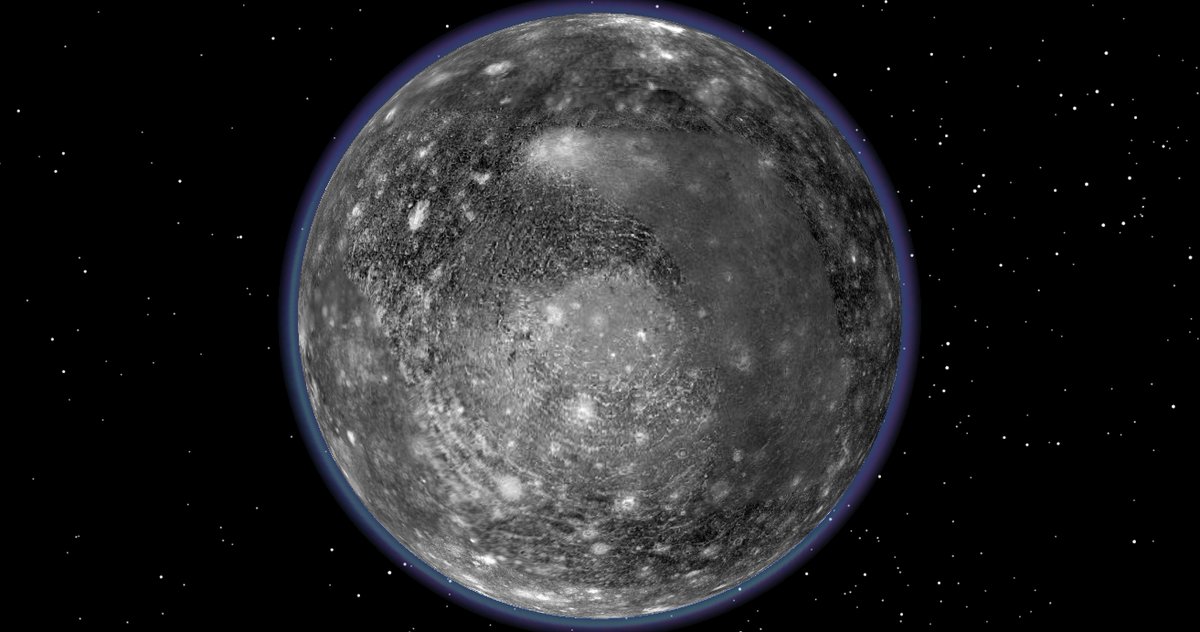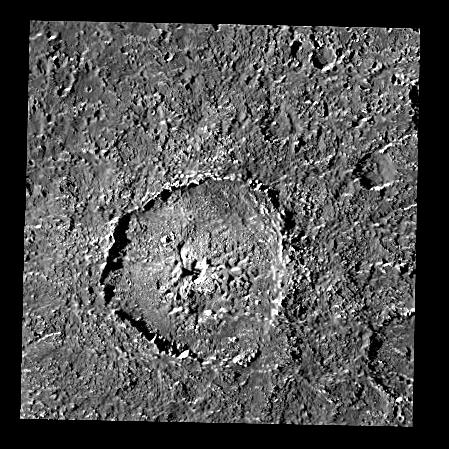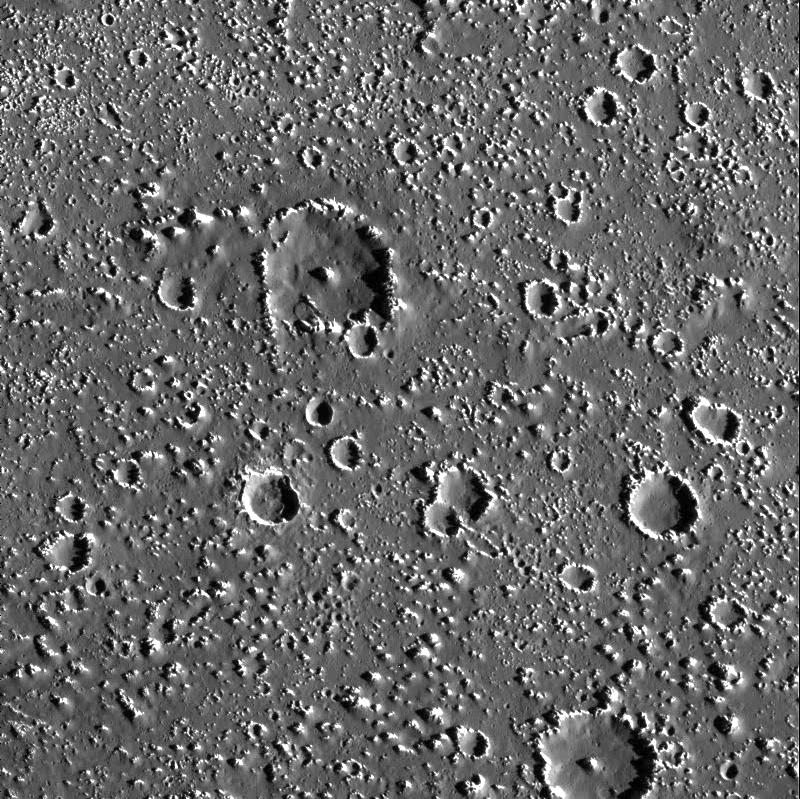Nobody cares about Jupiter’s moon Callisto, right?
Well, I care. Let’s #science up a thread about why Callisto is so neat!
(And what is the potential for alien life (or #astrobiology) in Callisto? I’ll speculate on that at the end…)
[1/n]
Well, I care. Let’s #science up a thread about why Callisto is so neat!
(And what is the potential for alien life (or #astrobiology) in Callisto? I’ll speculate on that at the end…)
[1/n]
Jupiter’s moons:
Io: I have volcanoes!
Europa: I might have life!
Ganymede: I’m the biggest moon in the Solar System!
Callisto: …
https://photojournal.jpl.nasa.gov/catalog/PIA01299">https://photojournal.jpl.nasa.gov/catalog/P...
Io: I have volcanoes!
Europa: I might have life!
Ganymede: I’m the biggest moon in the Solar System!
Callisto: …
https://photojournal.jpl.nasa.gov/catalog/PIA01299">https://photojournal.jpl.nasa.gov/catalog/P...
Callisto is bigger than our own moon and made of 50/50 rock and ice. The whole Jupiter system is kind of like a mini-Solar System. The tidal push and pull excitement that make Io super-active, Europa pretty active, and Ganymede active, make far out Callisto pretty much inactive.
All Jupiters condensed out from local gases. So Callisto got the least rock, and Io the most. Callisto didn& #39;t get much radioactive heating. So Callisto may/may not be differentiated way down deep.
https://photojournal.jpl.nasa.gov/catalog/PIA01082">https://photojournal.jpl.nasa.gov/catalog/P...
https://photojournal.jpl.nasa.gov/catalog/PIA01082">https://photojournal.jpl.nasa.gov/catalog/P...
That means that it might not have a real core, just a bunch of mixed up ice and rock way down deep. But maybe a thin liquid water ocean, and a thick ice outer crust. But maybe, just maybe, a little bit of layering way up at the top surface. Planetary Photojournal PIA01478
There is an idea, called the “Black Rain hypothesis” that after Jupiter and moons formed there were leftover rocky bits. These eventually (over a few hundred million years) landed on Jupiter’s moons.
Direct link to open-access pdf: https://www.boulder.swri.edu/~bottke/Reprints/Bottke_2013_Icarus_223_775_Black_rain_burial_galilean_satellites_irr_sat_debris.pdf">https://www.boulder.swri.edu/~bottke/R...
Direct link to open-access pdf: https://www.boulder.swri.edu/~bottke/Reprints/Bottke_2013_Icarus_223_775_Black_rain_burial_galilean_satellites_irr_sat_debris.pdf">https://www.boulder.swri.edu/~bottke/R...
Because of orbital reasons, Callisto got the most of these rocky bits, then Ganymede, then Europa, then Io. So after limited differentiation, Callisto got this rocky dusty stuff piled on the top. A lot, hundreds of meters. (Europa and Io got less, and have more active surfaces.)
(another link: https://skyandtelescope.org/astronomy-news/black-rain-on-callisto-andganymede/)">https://skyandtelescope.org/astronomy...
Callisto is darker than the other Galilean moons. Callisto is a third as bright as Europa, but twice as reflective as our own Moon. So if we swapped out Callisto for our Moon on tomorrows International Observe the Moon night, Callisto would be much brighter (reflectivity + size).
So let’s poke around the surface of Callisto and see some of the really wild stuff that’s down there. The first thing you notice about Callisto is that it is a crater wonderland. There are craters everywhere (sorta).
(**I’m using the USGS Callisto dataset and ArcGlobe to make these pictures. The a blue glow and stars are put around it by the software. Think of it as a gentle reminder that this is not an actual image. It is a mosaic.)
Download USGS Callisto mosaic here:
https://astrogeology.usgs.gov/search/map/Cal ">https://astrogeology.usgs.gov/search/ma...
https://astrogeology.usgs.gov/search/map/Cal ">https://astrogeology.usgs.gov/search/ma...
Callisto has these humongous things called multi-ring basins. A really big smack just really messed up the ice shell. Check this one out. It is called Valhalla. There are others, but this is my favorite.
I mean, srsly, you are looking at most of the hemisphere right there, right? Totally messed up!
Another thing, sorta-kinda special for Callisto are these big crater chains called “catena”. Look at this one. Just a bunch of craters lined up right after another. This one is 370 km long!
And that is inside the Valhalla structure. So you got the timing of things. Vallhalla boom! Then, the catena boom!
(actually, boom-boom-boom-boom-boom...!)
(actually, boom-boom-boom-boom-boom...!)
What makes these? These are impact crater chains. A lot of it has to do with Jupiter. Jupiter has a habit of ripping up comets and other thigns that get too close. Like comet Shoemaker -Levy. Jupiter ripped it up to make a train of broken up pieces.
https://www2.jpl.nasa.gov/sl9/background.html">https://www2.jpl.nasa.gov/sl9/backg...
https://www2.jpl.nasa.gov/sl9/background.html">https://www2.jpl.nasa.gov/sl9/backg...
Out at Callisto, farther from Jupiter& #39;s gravity well, the relative motion is not super-much, so that train of broken up pieces will just impact right after another if Callisto gets in the way: Boom!-Boom!-Boom!-Boom!
Imagine being on Callisto’s surface when these hit! You’d see each successive crater coming closer to you (or further) as each piece hit in a sequence depending on train orbit, and Callisto rotation-orbit. (And no, you wouldn’t have enough time to get away.)
Closer in, Callisto has a bunch of craters. Craters, craters, craters. Small ones are just a pit crater. But slightly bigger ones have domes and….pitted domes! Check out this one called….Tindr!
https://photojournal.jpl.nasa.gov/jpeg/PIA01657.jpg">https://photojournal.jpl.nasa.gov/jpeg/PIA0...
https://photojournal.jpl.nasa.gov/jpeg/PIA01657.jpg">https://photojournal.jpl.nasa.gov/jpeg/PIA0...
“Oh, I’m just checking out Tindr right now, dear! It’s all good!"
But seriously, check out Tindr crater on Callisto!
(There is a lot going on in this picture…we’ll get to that in a sec.)
https://photojournal.jpl.nasa.gov/jpeg/PIA01657.jpg">https://photojournal.jpl.nasa.gov/jpeg/PIA0...
But seriously, check out Tindr crater on Callisto!
(There is a lot going on in this picture…we’ll get to that in a sec.)
https://photojournal.jpl.nasa.gov/jpeg/PIA01657.jpg">https://photojournal.jpl.nasa.gov/jpeg/PIA0...
Inside the crater, the floor domed up, but then something came out of the dome, maybe some volatile gases like CO2. Even with Callisto’s boring history, there is plenty of time and nothing else going on, so that sublimation of CO2 and even H20 (ice) can happen.
Looking closer at Callisto’s ancient surface, you’d expect to see craters all the way down. Very few super-big, some medium, many small, lotsa small, and lotsa tiny-small. But if you zoom in, you don’t really see the small ones. Strange...
https://photojournal.jpl.nasa.gov/catalog/PIA01631">https://photojournal.jpl.nasa.gov/catalog/P...
https://photojournal.jpl.nasa.gov/catalog/PIA01631">https://photojournal.jpl.nasa.gov/catalog/P...
Check out this zoom image of Callisto’s surface. When you zoom way in things look…different.
You see those rims? Those are probably high standing crater rims of ice. Maybe bright stuff like H2O ice or CO2 that condensed on the bright stuff. (Bright stuff is cooler).
You see those rims? Those are probably high standing crater rims of ice. Maybe bright stuff like H2O ice or CO2 that condensed on the bright stuff. (Bright stuff is cooler).
Argh. Broken thread. Rejoin here. https://twitter.com/mike_malaska/status/1309636750445170689?s=19">https://twitter.com/mike_mala...

 Read on Twitter
Read on Twitter![Nobody cares about Jupiter’s moon Callisto, right?Well, I care. Let’s #science up a thread about why Callisto is so neat!(And what is the potential for alien life (or #astrobiology) in Callisto? I’ll speculate on that at the end…)[1/n] Nobody cares about Jupiter’s moon Callisto, right?Well, I care. Let’s #science up a thread about why Callisto is so neat!(And what is the potential for alien life (or #astrobiology) in Callisto? I’ll speculate on that at the end…)[1/n]](https://pbs.twimg.com/media/Eiy7bZ6VkAI4ldn.jpg)










